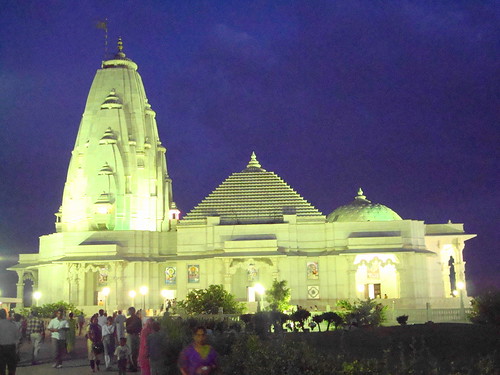Schera and I flew via Atlanta and Frankfurt to Mumbai in December 2006 and returned from Delhi in January 2007. The primary purpose of our trip was to be part of a "Reality Tour" led annually by Arun Gandhi, grandson of Mahatma Gandhi and founder of M. K. Gandhi Institute for Nonviolence. "Reality Tours" are arranged by Global Exchange of San Franciso, California, and the formal name is this tour is "India : The Gandhian Legacy and Grassroots Development."
The secondary purpose of our trip was to visit selected peace monuments (which -- in the area of India which we visited -- are mainly statues of Mahatma Gandhi). To see more monuments, we sometimes deviated from the guided "Reality Tour," and we remained in India three days after the tour ended in Dehradun. Notes about the monuments we visited are reported below under the names of the cities and areas we visited. The cities and areas are listed in the order in which we visited them.
By no means do these sites contain all of the peace monuments in India. Click here for peace monuments related to Mahatma Gandhi. Click here for other peace monuments in India.
United States
(See Tennessee, Gandhi)

| 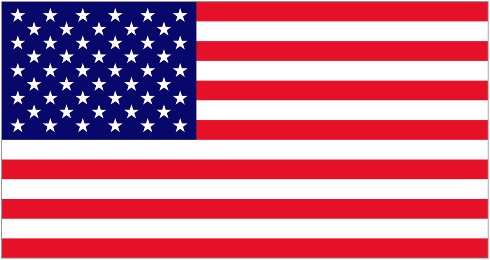  December 1-6, 2009 - "Ghandian Legacy & Philanthropy Tour" sponsored by GOPhilanthropic, 54 Seminole Way, Rochester, New York (USA). Guided by Arun Gandhi & Tushar Gandhi. "The trip begins in Mumbai visiting significant Gandhian sights as well as important humanitarian projects focused on health and economic development. We then travel South to Kolhapur were the Gandhis have begun work on a school project -- the Sunanda (Gandhi) Memorial School to provide education and shelter for children who would otherwise be locked into child labor and exploitation." Cost = $2500/person + $1000 philanthropic contribution to the Sunanda Memorial School = $3500 = $700/night for 5 nights.. December 1-6, 2009 - "Ghandian Legacy & Philanthropy Tour" sponsored by GOPhilanthropic, 54 Seminole Way, Rochester, New York (USA). Guided by Arun Gandhi & Tushar Gandhi. "The trip begins in Mumbai visiting significant Gandhian sights as well as important humanitarian projects focused on health and economic development. We then travel South to Kolhapur were the Gandhis have begun work on a school project -- the Sunanda (Gandhi) Memorial School to provide education and shelter for children who would otherwise be locked into child labor and exploitation." Cost = $2500/person + $1000 philanthropic contribution to the Sunanda Memorial School = $3500 = $700/night for 5 nights..
|
Germany
(See Germany)

| 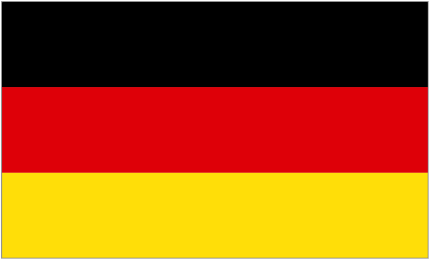 Date? - Rhein River, near Koblenz (Germany). Date? - Rhein River, near Koblenz (Germany).
|
We took advantage of the need to change planes in Frankfurt to make a one-day side trip to Koblenz (Germany). The first train we got on put us down in Meinz -- where my daughter and a German friend won a book making contest for the 600th anniversary of Guttenberg's birth in 2000. Changing train platforms in Meinz was not intuitive, and we lugged our baggage up and down several long stairways only to find ourselves in dead ends. Schera showed me the hospital in Bendorf am Rhein (a suburb of Koblenz) where she'd worked the Summer of ____, and I wanted to sail on the Rhein (at least for a few hours). There was no snow in Koblenz, but it was pretty cold, and tourist attractions -- like the cable car to Koblenz Castle and the Rhein river boats -- were shut down for the season. From the trains we took to and from Koblenz, we nevertheless saw several boats with tourists on board upstream from Koblenz. Somehow we had not been able to learn from the internet where Rhein river boats continue to operate in the Winter.
Mumbai
(See India-Gandhi, Statues, Museums for Peace)
  

| 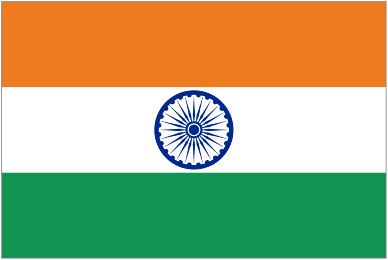 1955 - Mani Bhavan (Ghandi Sangaralaya), 19 Laburnum Road, Gamdevi, Mumbai, Maharashtra (India). "Whenever Gandhiji was in Mumbai between 1917 to 1934, he stayed here. It was from Mani Bhavan that Gandhi initiated Civil Disobedience, Satyagraha, Swadeshi, Khadi, and Khilafat movements." Gandhi was arrested here on January 4, 1932. The house was converted in 1955 into a museum and research centre. 1955 - Mani Bhavan (Ghandi Sangaralaya), 19 Laburnum Road, Gamdevi, Mumbai, Maharashtra (India). "Whenever Gandhiji was in Mumbai between 1917 to 1934, he stayed here. It was from Mani Bhavan that Gandhi initiated Civil Disobedience, Satyagraha, Swadeshi, Khadi, and Khilafat movements." Gandhi was arrested here on January 4, 1932. The house was converted in 1955 into a museum and research centre.
|
 |  Date? - Standing Statue of Mahatma Gandhi, Maharashtra State Secretariat, Mumbai, Maharashtra (India). "On February 26, 2008, Arun Gandhi was briefly held in custody for violating prohibitory orders before staging a protest in front of a statue of his grandfather at the State Secretariat in Mumbai, India. After being released, he stated his forced resignation [from the M. K. Gandhi Institute for Nonviolence in Rochester, New York] had 'implications for freedom of thought and speech' and that it 'indicates the power people have because of money and this had made a mockery of democratic principles.'" Date? - Standing Statue of Mahatma Gandhi, Maharashtra State Secretariat, Mumbai, Maharashtra (India). "On February 26, 2008, Arun Gandhi was briefly held in custody for violating prohibitory orders before staging a protest in front of a statue of his grandfather at the State Secretariat in Mumbai, India. After being released, he stated his forced resignation [from the M. K. Gandhi Institute for Nonviolence in Rochester, New York] had 'implications for freedom of thought and speech' and that it 'indicates the power people have because of money and this had made a mockery of democratic principles.'"
|

|  Date? - Ambedkar Statue, near the Oval Maidan, Mumbai (India). In landscaped traffic island. "The [Dalit & Buddhist] man who framed the Indian constitution stands against the backdrop of seat of law, the Mumbai high court. Unfortunately, Babasaheb Ambedkar is used to keep the caste divide intact. His name is used to play caste politics and no one follows his ideals anymore." "When in 1994 a garland of shoes was hung around a statue of Ambedkar in Mumbai, sectarian violence and strikes paralyzed the city for over a week." Date? - Ambedkar Statue, near the Oval Maidan, Mumbai (India). In landscaped traffic island. "The [Dalit & Buddhist] man who framed the Indian constitution stands against the backdrop of seat of law, the Mumbai high court. Unfortunately, Babasaheb Ambedkar is used to keep the caste divide intact. His name is used to play caste politics and no one follows his ideals anymore." "When in 1994 a garland of shoes was hung around a statue of Ambedkar in Mumbai, sectarian violence and strikes paralyzed the city for over a week."
|



|  Date? - Seated Statue of Mahatma Gandhi, at police station, Juhu Beach, Mumbai, Maharashtra (India). Click here for air view. Left photo by EWL. Right photo shows Gandhi at Juhu with his son Devdas. Date? - Seated Statue of Mahatma Gandhi, at police station, Juhu Beach, Mumbai, Maharashtra (India). Click here for air view. Left photo by EWL. Right photo shows Gandhi at Juhu with his son Devdas.
|


|  1968 -
Women's India Trust (WIT), Kamila Tyabji WIT Centre, Bunder Road, Panvel, near Mumbai (India). "WIT remains dedicated to the original aims of its founder, Kamila Tyabji: to help women to help themselves; to encourage women from less privileged backgrounds to acquire new skills; to give them the self-confidence and self esteem required to earn by their own industry and initiative; to enable them to carry this newly discovered skill and confidence into the wider world as well as within the framework of WIT." 1968 -
Women's India Trust (WIT), Kamila Tyabji WIT Centre, Bunder Road, Panvel, near Mumbai (India). "WIT remains dedicated to the original aims of its founder, Kamila Tyabji: to help women to help themselves; to encourage women from less privileged backgrounds to acquire new skills; to give them the self-confidence and self esteem required to earn by their own industry and initiative; to enable them to carry this newly discovered skill and confidence into the wider world as well as within the framework of WIT."
|




|  1978 - ISKCON Temple, Juhu, Mumbai (India). Also called Hare Rama Hare Krishna Temple. "The temple complex has a spacious marble temple, a top-end auditorium, a book-publishing house, a restaurant and a twin towered six storied guest house where visitors can stay and be a part of daily spiritual programs of the temple. Every day about 5,000 pilgrims visit the temple and on Sundays the number swells to over 10,000." 1978 - ISKCON Temple, Juhu, Mumbai (India). Also called Hare Rama Hare Krishna Temple. "The temple complex has a spacious marble temple, a top-end auditorium, a book-publishing house, a restaurant and a twin towered six storied guest house where visitors can stay and be a part of daily spiritual programs of the temple. Every day about 5,000 pilgrims visit the temple and on Sundays the number swells to over 10,000."
|

|  June 1980 -
SHARE (Save the Handicapped's Rehabilitation Efforts), Santa Cruz, Mumbai (India). "Founded by two sisters, the non-profit SHARE, worked with low-income women to make handmade patchwork quilts. Since that time the organization has grown to include 13 cooperatives that employ over 500 members. They have also expanded their product line to include clothing and household items, and broadened their market to the United States and Australia." MarketPlace operates under the umbrella organisation. Handwork of India, a women's cooperative, makes and exports apparel to the US. Over 450 women are today managing a turnover of $780,000. The initiative has transformed their lives. June 1980 -
SHARE (Save the Handicapped's Rehabilitation Efforts), Santa Cruz, Mumbai (India). "Founded by two sisters, the non-profit SHARE, worked with low-income women to make handmade patchwork quilts. Since that time the organization has grown to include 13 cooperatives that employ over 500 members. They have also expanded their product line to include clothing and household items, and broadened their market to the United States and Australia." MarketPlace operates under the umbrella organisation. Handwork of India, a women's cooperative, makes and exports apparel to the US. Over 450 women are today managing a turnover of $780,000. The initiative has transformed their lives.
|
Mumbai gave us our first tastes of India's sights, sounds, smells, congestion, and ubiquitous poverty. Schera and I taxied downtown even before the "Reality Tour" began. Then the group spent most a day taking a boat from the
1924 Gateway of India (where a woman was raped on New Years Eve while we were in town and where terrorists would land on November 26, 2008) to and from the Elephanta Caves -- and most of a day taking a bus to and from the Women's Indian Trust Center in Panvel east of Mumbai Bay. /// One evening we all walked from our hotel -- the Ramee Guestline in Juhu -- to the Hare Krishna Temple for a vegetarian dinner.
 (This was the only religious site visited on the entire tour. Arun Gandhi never led us to a mosque, a church, or any other kind of temple.) /// The tour ran out of things to do at SHARE/MarketPlace. While the group sat around in a stuffy little room (and some of the women got their hands painted), I walked alone into a Hindu
temple across the street and received a wonderful welcome, including a tour (both upstairs and down) of many nitches holding statues of Hindu divinities and a recital of music performed by three women sitting cross-legged in the middle of the upstairs floor. /// Also near our hotel in Juhu was St. Joseph's Church
(This was the only religious site visited on the entire tour. Arun Gandhi never led us to a mosque, a church, or any other kind of temple.) /// The tour ran out of things to do at SHARE/MarketPlace. While the group sat around in a stuffy little room (and some of the women got their hands painted), I walked alone into a Hindu
temple across the street and received a wonderful welcome, including a tour (both upstairs and down) of many nitches holding statues of Hindu divinities and a recital of music performed by three women sitting cross-legged in the middle of the upstairs floor. /// Also near our hotel in Juhu was St. Joseph's Church
 (whose burial markers displayed Portuguese names) and St. Joseph's High School (which had a magnificent year-end display near its gate combining a salt-marching Mahatma Gandhi, Lage Raho Munna Bhai -- the recent comedy featuring the ghost of Gandhi -- symbols of many different religions, and little models of the seven Mumbai train cars which had been bombed on July 11, 2006). /// I had learned about the seated Gandhi statue at the police station on Juhu Beach from Jyotindra (Joe) Shukla (former president of the Knoxville Hindu Cultural Center), so made a point of walking there from
our hotel. Getting to the Gandhi statue nestled among government buildings in central Mumbai was another matter. While the tour group dined in a seafood restaurant, I proposed to walk to the statue. Group leaders vetoed my proposal but instructed our driver and his assistant to take Schera and me there in their
(whose burial markers displayed Portuguese names) and St. Joseph's High School (which had a magnificent year-end display near its gate combining a salt-marching Mahatma Gandhi, Lage Raho Munna Bhai -- the recent comedy featuring the ghost of Gandhi -- symbols of many different religions, and little models of the seven Mumbai train cars which had been bombed on July 11, 2006). /// I had learned about the seated Gandhi statue at the police station on Juhu Beach from Jyotindra (Joe) Shukla (former president of the Knoxville Hindu Cultural Center), so made a point of walking there from
our hotel. Getting to the Gandhi statue nestled among government buildings in central Mumbai was another matter. While the tour group dined in a seafood restaurant, I proposed to walk to the statue. Group leaders vetoed my proposal but instructed our driver and his assistant to take Schera and me there in their
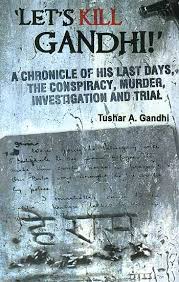 immense chartered bus. I've never had such service. On our return to the restaurant, the driver asked if I'd also like to visit the statue of B. R. Ambedkar [1891-1956]. I said sure and was duly deposited on the edge of a landscaped traffic island, but no sooner had I approached the statue than a uniformed guard shooed me away. I learned later about some of the security problems which have worried Mumbai for many years (see above). /// The tour group never had a room to met in at the hotel. This meant, among other things, that we never really got to know each other and never received much input from Arun Gandhi. When his son Tushar Gandhi came to speak to us about his new
book, Let's Kill Gandhi, he did so while we remained seated on our noisily air conditioned chartered bus parked in front of the hotel. Tushar Gandhi said that the principal reason for Matahma Gandhi's assassination in 1948 was opposition he had received for many years from group of Brahmins in the city of Pune.
Pune
immense chartered bus. I've never had such service. On our return to the restaurant, the driver asked if I'd also like to visit the statue of B. R. Ambedkar [1891-1956]. I said sure and was duly deposited on the edge of a landscaped traffic island, but no sooner had I approached the statue than a uniformed guard shooed me away. I learned later about some of the security problems which have worried Mumbai for many years (see above). /// The tour group never had a room to met in at the hotel. This meant, among other things, that we never really got to know each other and never received much input from Arun Gandhi. When his son Tushar Gandhi came to speak to us about his new
book, Let's Kill Gandhi, he did so while we remained seated on our noisily air conditioned chartered bus parked in front of the hotel. Tushar Gandhi said that the principal reason for Matahma Gandhi's assassination in 1948 was opposition he had received for many years from group of Brahmins in the city of Pune.
Pune
(See India-Gandhi, Museums for Peace, Graves)
 

|  Date? - Gandhi's Ashes, Aga Khan Palace, Pune, Maharashtra (India). Also ashes of Gandhi's wife Kasturba [1869-1944] and secretary Mahdev Desai [1892-1942], both of whom died while emprisoned in the palace. Date? - Gandhi's Ashes, Aga Khan Palace, Pune, Maharashtra (India). Also ashes of Gandhi's wife Kasturba [1869-1944] and secretary Mahdev Desai [1892-1942], both of whom died while emprisoned in the palace.
|
 |  1969 - Aga Kahn Palace, Pune, Maharashtra (India). Where Gandhi, his wife Kasturba, and his secretary Mahadevbhai Desai were interned from August 9, 1942 to May 6, 1944 (& where the latter two died). Palace built in 1892. Museum management transferred to the Gandhi Memorial Society in 1980. 1969 - Aga Kahn Palace, Pune, Maharashtra (India). Where Gandhi, his wife Kasturba, and his secretary Mahadevbhai Desai were interned from August 9, 1942 to May 6, 1944 (& where the latter two died). Palace built in 1892. Museum management transferred to the Gandhi Memorial Society in 1980.
|
 |  Date? - Babasaheb Ambedkar Museum, Senapati Bapat Road, Pune, Maharashtra (India). "Dedicated to Dr. Babasaheb Ambedkar, a freedom fighter who later wrote the Constitution of the independent India. Contains items representing his entire life, right from his birth to his death. Also a marble statue of Dr. Babasaheb adorning the interiors of the museum." Date? - Babasaheb Ambedkar Museum, Senapati Bapat Road, Pune, Maharashtra (India). "Dedicated to Dr. Babasaheb Ambedkar, a freedom fighter who later wrote the Constitution of the independent India. Contains items representing his entire life, right from his birth to his death. Also a marble statue of Dr. Babasaheb adorning the interiors of the museum."
|
We passed through Pune twice at night, both en route to and return from Miraj Junction (the railroad station for Sangli), thus missing the Aga Kahn Palace, where Kasturba Gandhi died while emprisoned by the British, not to mention the Babasaheb Ambedkar Museum. Before going to India, I printed a recent article by ____ (http://www.gandhiserve.org/_____) describing negative Dalit reactions to measures on their behalf by non-Dalit citizens of Pune. I loaned the print-out to Arun Gandhi in Sangli. When he returned it to me the next morning, he said that he'd read it and that he knew its author, but he never said anything about it or about Pune to the tour group as a whole. Except from our Sikh taxi driver in Mussoori (see below), we never heard anything negative about Mahatma Gandhi -- or his legacy -- all the time that we were in India.
Sangli & Kolhapur
(See India-Gandhi, Statues, Towers)
![]()
|  Date? - ____ School, Sangli, Maharashtra State (India). Presided over by famous elder. Military connections. Date? - ____ School, Sangli, Maharashtra State (India). Presided over by famous elder. Military connections.
|
![]()
|  Date? - Freedom Fighters Monument, ____ School, Sangli, Maharashtra State (India). Date? - Freedom Fighters Monument, ____ School, Sangli, Maharashtra State (India).
|
It was hard to know what we did in Sangli and Kolhapur. Neither Arun Gandhi nor Global Exchange ever showed us anything in writing about our itinerary -- before, during, or after the tour. The group visited a large school in Sangli, and then we got on a bus and started driving a long distance out of town. The scenes of rural life on both sides of the road were facinating, but none of us had any idea where we going. Gandhi obviously had it all planned. In one town, a delegation of city fathers met the bus. No one got off except Gandhi, and he was ushered to the monument in the middle of a roundabout where he planted a wreath or some such amid a lot of well wishing, laying on of marigold garlands, and so forth. Gandhi got back on our bus, and we resumed out drive toward what turned out to be Kolhapur, there to mix with a lot of school children for the dedication of a new school -- or rather of the plans for a new school.
Dandi
(See India-Gandhi, Statues, Towers)
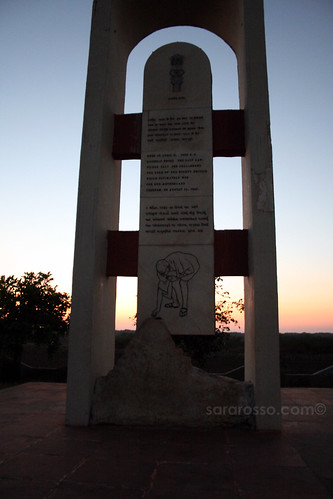

|  Date? - Salt March Monument, Dandi, ____, State (India). This monument stands next to a larger-than-life statue of Gandhi bending down and picking up the salty mud that he would later boil and extract salt from. The inscription reads:
“Here On April 6, 1930, Gandhiji Broke The Salt Law Picked Salt And Challenged The Rule Of The Mighty British Which Ultimately Won For Our Motherland Freedom on August 15, 1947.” Date? - Salt March Monument, Dandi, ____, State (India). This monument stands next to a larger-than-life statue of Gandhi bending down and picking up the salty mud that he would later boil and extract salt from. The inscription reads:
“Here On April 6, 1930, Gandhiji Broke The Salt Law Picked Salt And Challenged The Rule Of The Mighty British Which Ultimately Won For Our Motherland Freedom on August 15, 1947.”
|
After returning to Mumbai and spending the day at ___, we took another over-night train, this time to Ahmedabad. Some time during the night, we passed through or close to Dandi, the seaside town to which Mahatma Gandhi led the so-called Salt March (Salt Satyagraha) in 1930. A monument marks the spot where he gathered salty sand and boiled off edible salt to defy the British. From time to time, groups reenact the 240-mile/390 km march by walking from the Sabarmati Ashram to Nandi. We covered the same distance, at night, in reverse, and by train.
Gugarat State
(See India-Gandhi, Statues, Museums for Peace)




|  Before 1963 - Sabarmati Ashram, Ahmedabad, Gugarat (India). Also called Harijan Ashram or Gandhi Ashram. On bank of Sabarmati River adjacent to Gandhi Memorial Instituton. Sabarmati is the starting point of the Salt March in 1930 (right image). Ashram complex includes historic preservations, prayer ground, school, and artisenal factories. When opened to the public? Before 1963 - Sabarmati Ashram, Ahmedabad, Gugarat (India). Also called Harijan Ashram or Gandhi Ashram. On bank of Sabarmati River adjacent to Gandhi Memorial Instituton. Sabarmati is the starting point of the Salt March in 1930 (right image). Ashram complex includes historic preservations, prayer ground, school, and artisenal factories. When opened to the public?
|


 |  May 10, 1963 -
Gandhi Smarak Sangrahalaya / Gandhi Memorial Institution, Ahmedabad, Gugarat (India). On bank of Sabarmati River adjacent to Sabarmati Ashram (also called Harijan Ashram).
"Houses personal memorabilia of Mahatma Gandhi. Consequently the exhibits on view depict the vivid and historic events of Gandhiji's life.
There are books, manuscripts and photostat copies of his correspondence, photographs of Gandhiji with his wife Kasturba and other ashram
associates, life size oil paintings and actual relics like his writing desk and spinning wheel." Operated by Sabarmati Ashar Preservation & Memorial Trust. Listed in UN directory "Peace Museums Worldwide" (1998). May 10, 1963 -
Gandhi Smarak Sangrahalaya / Gandhi Memorial Institution, Ahmedabad, Gugarat (India). On bank of Sabarmati River adjacent to Sabarmati Ashram (also called Harijan Ashram).
"Houses personal memorabilia of Mahatma Gandhi. Consequently the exhibits on view depict the vivid and historic events of Gandhiji's life.
There are books, manuscripts and photostat copies of his correspondence, photographs of Gandhiji with his wife Kasturba and other ashram
associates, life size oil paintings and actual relics like his writing desk and spinning wheel." Operated by Sabarmati Ashar Preservation & Memorial Trust. Listed in UN directory "Peace Museums Worldwide" (1998).
|
 |  Date? - Standing Statue of Mahatma Gandhi, Ahmedabad (India). At intersection just west of Sabaramati River bridge. Completely surrounded by traffic. Just south of Sabarmati Ashram, this intersection is where Gandhi's 1930 Salt March turned left in order to cross the Sabarmati River en route to Dandi. Photo by EWL
. Date? - Standing Statue of Mahatma Gandhi, Ahmedabad (India). At intersection just west of Sabaramati River bridge. Completely surrounded by traffic. Just south of Sabarmati Ashram, this intersection is where Gandhi's 1930 Salt March turned left in order to cross the Sabarmati River en route to Dandi. Photo by EWL
.
|

|  January 26, 2001 - Gandhi Statue, Gandhidham, Gugarat (India). "Many buildings, including several medium high-rise buildings collapsed during the Bhuj Earthquke on January 26, 2001. A statue of Mahatma Gandhi was knocked down as the pedestal collapsed." January 26, 2001 - Gandhi Statue, Gandhidham, Gugarat (India). "Many buildings, including several medium high-rise buildings collapsed during the Bhuj Earthquke on January 26, 2001. A statue of Mahatma Gandhi was knocked down as the pedestal collapsed."
|


|  October 13, 2005 - Seva Cafe, Shopper’s Plaza (4th Floor), opposite Municipal Market, C.G. Road, Ahmenabad, Gugarat (India). "Seva means service. Seva Café is an experiment in the shared joy that comes from humble giving and selfless service. As we serve, we internalize the mantra of "Atithi Devo Bhava" which translates to "The Guest is God," a deep and ancient Indian view that honors each guest with reverence. When you dine at Seva Café, you are not viewed as a customer, but instead as our treasured guest, as part of our family.
" October 13, 2005 - Seva Cafe, Shopper’s Plaza (4th Floor), opposite Municipal Market, C.G. Road, Ahmenabad, Gugarat (India). "Seva means service. Seva Café is an experiment in the shared joy that comes from humble giving and selfless service. As we serve, we internalize the mantra of "Atithi Devo Bhava" which translates to "The Guest is God," a deep and ancient Indian view that honors each guest with reverence. When you dine at Seva Café, you are not viewed as a customer, but instead as our treasured guest, as part of our family.
"
|
The Sabarmati Ashram was the highlight of the entire "Reality Tour." It had everything: Museum, Gandhi statue, historc preservations, Gandhi's prayer ground, a view of the river, cute ground squirrels, meeting rooms, book store, computer lab, food, dancing school girls, and factories (aross the street) producing neem soap, artisanal paper, and hand spinning machines. The tour visited SEWA in several different ways (including its new TV production studio), but two meetings took place with everyone sitting on the floor (ugggh). I used a free hour to take an auto rickshaw to photograph the Gandhi statue in the middle of a busy life-threatening intersection. My first driver said he understood what I wanted but drove in the opposite direction, taking me deeper and deeper into a slum, until I jumped out, fearing momentarily if I would ever find my way back to terra cognita. On an Ahmedabad sidewalk I bought large colorful posters depicting Mahatma Gandhi, B. R. Ambedkar, and Swami Viveananda [1863-1902] -- who "introduced" Hinduism to the West in Chicago in 1893. During our stay in Ahmedabad, a local newspaper described a forthcoming exhibition which was going to use computers and various high-tech media to present Mahatma Gandhi and his meaning for modern society. I asked Arun Gandhi about this. He scoffed and said such means disrespect his grandfather and mislead the public. "You'll see," he said, "how bad this sort of thing can be when we visit Delhi." He was refering, I guess, to the "modern" display on the second floor of Birla House, but, when we got to Delhi, Birla House was never mentioned. Did Gandhi not know where we were going on this year's tour? Was our schedule so loose that some parts were dropped or added at the last minute? I never learned answers to these questions.
Jaipur
(See India-Gandhi, Statues)
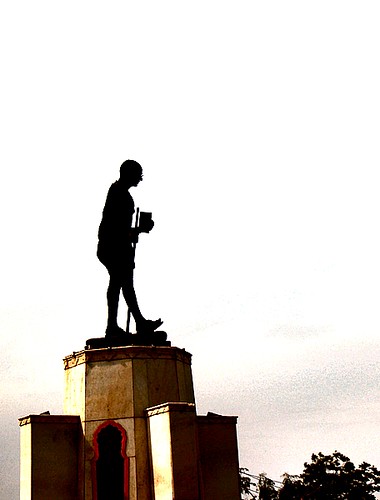

|  Date? - Gandhi Statue, Roundabout, Jaipur (India). Date? - Gandhi Statue, Roundabout, Jaipur (India).
|
The gated city of Jaipur, capital of the desert state of Rajasthan, is another city we passed through at night. Probably nothing there to merit a stop. There are Gandhi statues everywhere in India. Jaipur attracts many tourists, and several members of the "Reality Tour" retrurned there on their own after the tour ended in Delhi.
http://4.bp.blogspot.com/_1uiMWDd8P2k/R4mHaJEgxRI/AAAAAAAAAHo/L5W1U0oNjT0/s400/Mumbai%2B028Gandhi.jpg
Delhi
(See India-Gandhi, Statues, Sculpture, Gongs, Museums for Peace, Bahai)



|
 January 31, 1948 - Raj Ghat, New Delhi (India). Where Gandhi's body
was cremated, and a shrine ever since. A commemorative ceremony takes place every Friday. Remembrance prayers are held on anniversaries of Gandhi's Birth ( October 2) & Death (January30). The latter is called Martyr's Day. Gandhi's ashes were sent to the Ganges, Pune (qv), other sites in India, the Nile (Uganda) & Pacific Palisades, California (USA). January 31, 1948 - Raj Ghat, New Delhi (India). Where Gandhi's body
was cremated, and a shrine ever since. A commemorative ceremony takes place every Friday. Remembrance prayers are held on anniversaries of Gandhi's Birth ( October 2) & Death (January30). The latter is called Martyr's Day. Gandhi's ashes were sent to the Ganges, Pune (qv), other sites in India, the Nile (Uganda) & Pacific Palisades, California (USA).  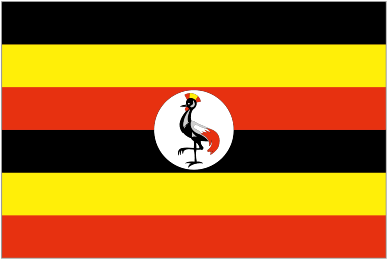 
|
 |  January 30, 1961 - National Gandhi Museum & Library, Rajghat, New Delhi, (India). Occupied present location in 1961, but origins of the museum go back to 1951. Operated by Gandhi Smarak Sangrahalaya Samiti. Listed in UN directory "Peace Museums Worldwide" (1998). January 30, 1961 - National Gandhi Museum & Library, Rajghat, New Delhi, (India). Occupied present location in 1961, but origins of the museum go back to 1951. Operated by Gandhi Smarak Sangrahalaya Samiti. Listed in UN directory "Peace Museums Worldwide" (1998).
|

|  Date? - Statue of Gandhi on the Salt March, National Gandhi Museum & Library, Rajghat, New Delhi (India). Image courtesy of Peter Nais, director of The Peace Muesum, Bradford (England). Date? - Statue of Gandhi on the Salt March, National Gandhi Museum & Library, Rajghat, New Delhi (India). Image courtesy of Peter Nais, director of The Peace Muesum, Bradford (England).
|
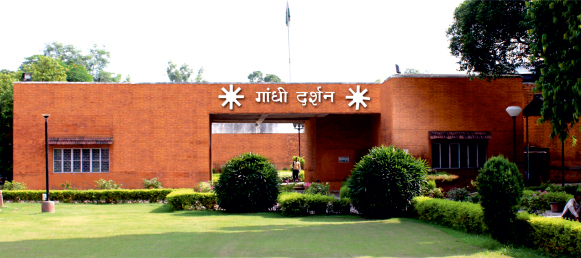 |  1969? -
Gandhi Darshan or Gandhi Samadhi, Rajghat, New Delhi (India). Merged in September 1984 with Gandhi Smriti (qv) to form "Gandhi Smriti and Darshan Samiti" (GSDS). 1969? -
Gandhi Darshan or Gandhi Samadhi, Rajghat, New Delhi (India). Merged in September 1984 with Gandhi Smriti (qv) to form "Gandhi Smriti and Darshan Samiti" (GSDS).
|

|  Date? - Gandhi Statue, Gandhi Darshan or Gandhi Samadhi, Rajghat, , New Delhi (India). Image courtesy of Peter Nais, director of The Peace Muesum, Bradford (England). Date? - Gandhi Statue, Gandhi Darshan or Gandhi Samadhi, Rajghat, , New Delhi (India). Image courtesy of Peter Nais, director of The Peace Muesum, Bradford (England).
|




|  August 15, 1973 - Gandhi Smriti, Birla Bhavan / Birla House, 5 Tees January Marg, New Delhi (India). Home of industrialist Ghanshyam Das Birla [1894-1983]. Now includes Gandhi museum, bookshop, room in which Gandhi lodged for 144 days after September 9, 1947, his last footsteps on January 30, 1948, and the garden in which he was assassinated. Merged in September 1984 with Gandhi Darshan (qv) to form "Gandhi Smriti and Darshan Samiti (GSDS). August 15, 1973 - Gandhi Smriti, Birla Bhavan / Birla House, 5 Tees January Marg, New Delhi (India). Home of industrialist Ghanshyam Das Birla [1894-1983]. Now includes Gandhi museum, bookshop, room in which Gandhi lodged for 144 days after September 9, 1947, his last footsteps on January 30, 1948, and the garden in which he was assassinated. Merged in September 1984 with Gandhi Darshan (qv) to form "Gandhi Smriti and Darshan Samiti (GSDS).
|

|  Date? -
Statue of Mahatma Gandhi, Gandhi Smriti, Birla Bhavan / Birla House, New Delhi (India). Depicts Gandhi with two harijan / untouchable children. Sculpted by Ram V. Sutar. Duplicate statues at Sandur, Bangalore, and Delhi Public School, Noida. Sutar also sculpted the Gandhi statue at the Martin Luther King, Jr., National Historic Site in Atlanta, Georgia (USA). Date? -
Statue of Mahatma Gandhi, Gandhi Smriti, Birla Bhavan / Birla House, New Delhi (India). Depicts Gandhi with two harijan / untouchable children. Sculpted by Ram V. Sutar. Duplicate statues at Sandur, Bangalore, and Delhi Public School, Noida. Sutar also sculpted the Gandhi statue at the Martin Luther King, Jr., National Historic Site in Atlanta, Georgia (USA). 
|

|  November 6, 2005 - Swaminarayan Akshardham Temple, Yamuna River,
New Delhi (India). Click here for the Wikipedia article. There is an older Swaminarayan Akshardham Temple in Ahmendabd, Gujarat (India). November 6, 2005 - Swaminarayan Akshardham Temple, Yamuna River,
New Delhi (India). Click here for the Wikipedia article. There is an older Swaminarayan Akshardham Temple in Ahmendabd, Gujarat (India).
|
 |  2007 -
Vishwa Shanti Stupa / Peace Pagoda, Indraprasht Park, New Delhi (India). "Unveiled by His Holiness the Dalai Lama. The landmark also houses some of Budha’s relics in it. The Stupa stands against the backdrop of some magnificent historical buildings like the Old Fort and Humayun’s tomb. The “Vishwa Shanti Stupa” is 28 meters high. Its construction was inspired by the world famous Shanti Stupa at Sanchi in Madhya Pradesh (qv)....74th in the series of stupas or pagodas around the world." 2007 -
Vishwa Shanti Stupa / Peace Pagoda, Indraprasht Park, New Delhi (India). "Unveiled by His Holiness the Dalai Lama. The landmark also houses some of Budha’s relics in it. The Stupa stands against the backdrop of some magnificent historical buildings like the Old Fort and Humayun’s tomb. The “Vishwa Shanti Stupa” is 28 meters high. Its construction was inspired by the world famous Shanti Stupa at Sanchi in Madhya Pradesh (qv)....74th in the series of stupas or pagodas around the world."
|
Except for Vandana Shiva (see below), the "Gandhian Legacy and Grassroots Development" tour was practically over by the time we got to Delhi. The group went to the Raj Ghat, but everything else it did in Delhi was pure tourism -- a "cultural" perfomance of singing and dancing, touring historic monuments near our hotel in the southern part of the city (e.g. the Gutub Minar), and taking a very long and tiring day to visit the
 Taj Mahal and Red Fort in Agra (200 km east of Delhi). Schera and I avoided Agra and the Taj. It may be the most beautiful monument in the world, but nobody
claims it to be a "peace monument." (Besides, I'd seen it in 1961.) /// Instead, we had tea with Mr. and Mrs. Rajinder Singh Bedi -- whom we knew through the Rotary Global History Fellowship (RGHF) -- and visited the beautiful Lotus Temple, the colossal Swaminarayan Akshardham Temple, the impressive Gyarah Murti monument, and historic Birla House. The larger than life-size Gyarah Murti became my favorite peace monument of any time or location. (To my great regret, I have never been able to find the date on which this masterpiece was dedicated.) A visit to Birla House -- including Gandhi's last bedroom and the path he took to the prayer ground on which he was assassinated in 1948 -- would, in my opinion, be impossible to exclude from any Gandhi pilgrimage worthy of the name. The centennial of Gandhi's Satyagraha speech at the Empire Theater in Johannesburg, South Africa, had just taken place on September 11, and two centennial monuments had been added to the Birla House grounds -- an outdoor exhibit of Gandhi's career in South Africa and a huge World Peace Gong from Indonesia. I'd never heard of World Peace Gongs before, and accidentally coming across such a gong was very exciting. A clerk in the Birla House bookshop proudly showed me a copy of "Mohandas: A True Story of a Man, his People and an Empire" (not yet published in the US). Foolishly, I declined to purchase it -- but did so later. /// I regret that time did not permit our also visiting Old Delhi, the Jama Masjid Mosque, the Red Fort, Birla Mandir, the two other Gandhi museums (see above, including the two statues photographed by Peter Nais), and several other Delhi landmarks.
Dehradun, Uttarakhand
Taj Mahal and Red Fort in Agra (200 km east of Delhi). Schera and I avoided Agra and the Taj. It may be the most beautiful monument in the world, but nobody
claims it to be a "peace monument." (Besides, I'd seen it in 1961.) /// Instead, we had tea with Mr. and Mrs. Rajinder Singh Bedi -- whom we knew through the Rotary Global History Fellowship (RGHF) -- and visited the beautiful Lotus Temple, the colossal Swaminarayan Akshardham Temple, the impressive Gyarah Murti monument, and historic Birla House. The larger than life-size Gyarah Murti became my favorite peace monument of any time or location. (To my great regret, I have never been able to find the date on which this masterpiece was dedicated.) A visit to Birla House -- including Gandhi's last bedroom and the path he took to the prayer ground on which he was assassinated in 1948 -- would, in my opinion, be impossible to exclude from any Gandhi pilgrimage worthy of the name. The centennial of Gandhi's Satyagraha speech at the Empire Theater in Johannesburg, South Africa, had just taken place on September 11, and two centennial monuments had been added to the Birla House grounds -- an outdoor exhibit of Gandhi's career in South Africa and a huge World Peace Gong from Indonesia. I'd never heard of World Peace Gongs before, and accidentally coming across such a gong was very exciting. A clerk in the Birla House bookshop proudly showed me a copy of "Mohandas: A True Story of a Man, his People and an Empire" (not yet published in the US). Foolishly, I declined to purchase it -- but did so later. /// I regret that time did not permit our also visiting Old Delhi, the Jama Masjid Mosque, the Red Fort, Birla Mandir, the two other Gandhi museums (see above, including the two statues photographed by Peter Nais), and several other Delhi landmarks.
Dehradun, Uttarakhand
(See India-Gandhi, Statues, Peacemakers)

|  Date? - Statue of Mahatma Gandhi, Dehradun, Uttarakhand (India). "Gandhijiri. A worker repairs the statue of Mahatma Gandhi, which was damaged by miscreants a few days ago, at Dehradun's Gandhi Park." Typically, in the middle of a busy street and therefore difficult (and unsafe) to photograph. Date? - Statue of Mahatma Gandhi, Dehradun, Uttarakhand (India). "Gandhijiri. A worker repairs the statue of Mahatma Gandhi, which was damaged by miscreants a few days ago, at Dehradun's Gandhi Park." Typically, in the middle of a busy street and therefore difficult (and unsafe) to photograph.
|

|  1982 - Navdanya Farm & Research Foundation for Science, Technology and Ecology (RFSTE), Dehradun, Uttarakhand (India). Founded & headed by Vandana Shiva on her family farm. "The seed bank in the farm at Dehradun preserves 300 land races of paddy, 31 land races of wheat, 11 land races of barley, 5 varieties of barnyard millet, 10 varieties of oats, 6 varieties of finger millet, 3 varieties of foxtail millet, and 7 varieties of mustard." Click here for a 360-degree panorama via YouTube. 1982 - Navdanya Farm & Research Foundation for Science, Technology and Ecology (RFSTE), Dehradun, Uttarakhand (India). Founded & headed by Vandana Shiva on her family farm. "The seed bank in the farm at Dehradun preserves 300 land races of paddy, 31 land races of wheat, 11 land races of barley, 5 varieties of barnyard millet, 10 varieties of oats, 6 varieties of finger millet, 3 varieties of foxtail millet, and 7 varieties of mustard." Click here for a 360-degree panorama via YouTube.
|
The only reason that Arun Gandhi took the "Reality Tour" to Dehradun was to meet Vandana Shiva,
 and she spoke to us at our hotel on the evening of our arrival. Next day, her brother (a retired Indian Air Force officer) welcomed us to the Navdanya farm several miles outside of town. As we walked among rice paddies, Arun Gandhi told those within earshot to look up and see a gray profile of mountains. Visible only a minute or two, this was the only view the "Reality Tour" ever received of the mountainous wall which encloses India on the north. (Pollution enveloped us everywhere else.) That evening -- the very last evening of the tour -- we had our first and only real discussion with Arun Gandhi about non-violence and other principles of his grandfather, Mahatma Gandhi. Finding a room to accomodate the 30+ members of the tour had been a constant problem since the beginning of the tour in Mumbai, and -- in our opinion -- the tour failed to live up to its one of its primary purposes, i.e. to include a running seminar with Arun Gandhi -- and with each other -- all the time we were in India.
Mussoorie, Uttarakhand
and she spoke to us at our hotel on the evening of our arrival. Next day, her brother (a retired Indian Air Force officer) welcomed us to the Navdanya farm several miles outside of town. As we walked among rice paddies, Arun Gandhi told those within earshot to look up and see a gray profile of mountains. Visible only a minute or two, this was the only view the "Reality Tour" ever received of the mountainous wall which encloses India on the north. (Pollution enveloped us everywhere else.) That evening -- the very last evening of the tour -- we had our first and only real discussion with Arun Gandhi about non-violence and other principles of his grandfather, Mahatma Gandhi. Finding a room to accomodate the 30+ members of the tour had been a constant problem since the beginning of the tour in Mumbai, and -- in our opinion -- the tour failed to live up to its one of its primary purposes, i.e. to include a running seminar with Arun Gandhi -- and with each other -- all the time we were in India.
Mussoorie, Uttarakhand
(See India-Gandhi, Statues, Sculpture, Artists, Monuments For Sale)

|  1854 - Woodstock School, Mussoorie, Uttarakhand (India). "One of the most highly esteemed Christian international schools in South Asia. Our alumni are active in almost every part of the globe and continue to support the development of this exciting and effective centre of learning." 1854 - Woodstock School, Mussoorie, Uttarakhand (India). "One of the most highly esteemed Christian international schools in South Asia. Our alumni are active in almost every part of the globe and continue to support the development of this exciting and effective centre of learning."
|

|  1959 - Tibetan Buddhist Temple, Happy Valley Road, Mussoorie, Uttarakhand (India). "Dalai Lama took refuge in Mussoorie after he fled Tibet [in 1959. Later he] was granted land in Dharamshala by the then Prime Minister Pandit Jawaharlal Nehru. The temple has a divine atmosphere, and those seeking solace and peace of mind must make it a point to visit here. To add to the serenity are the clay lamps in the lamp house and the prayer flags." 1959 - Tibetan Buddhist Temple, Happy Valley Road, Mussoorie, Uttarakhand (India). "Dalai Lama took refuge in Mussoorie after he fled Tibet [in 1959. Later he] was granted land in Dharamshala by the then Prime Minister Pandit Jawaharlal Nehru. The temple has a divine atmosphere, and those seeking solace and peace of mind must make it a point to visit here. To add to the serenity are the clay lamps in the lamp house and the prayer flags." 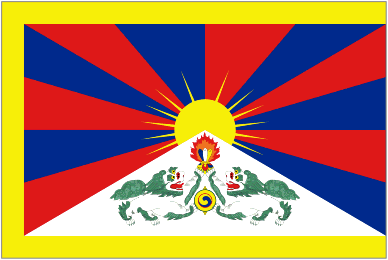
|
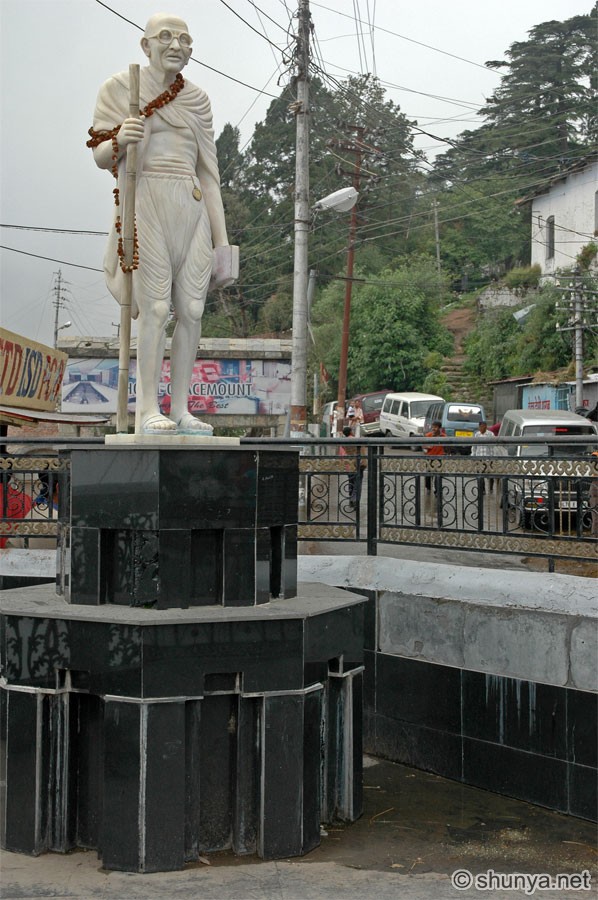
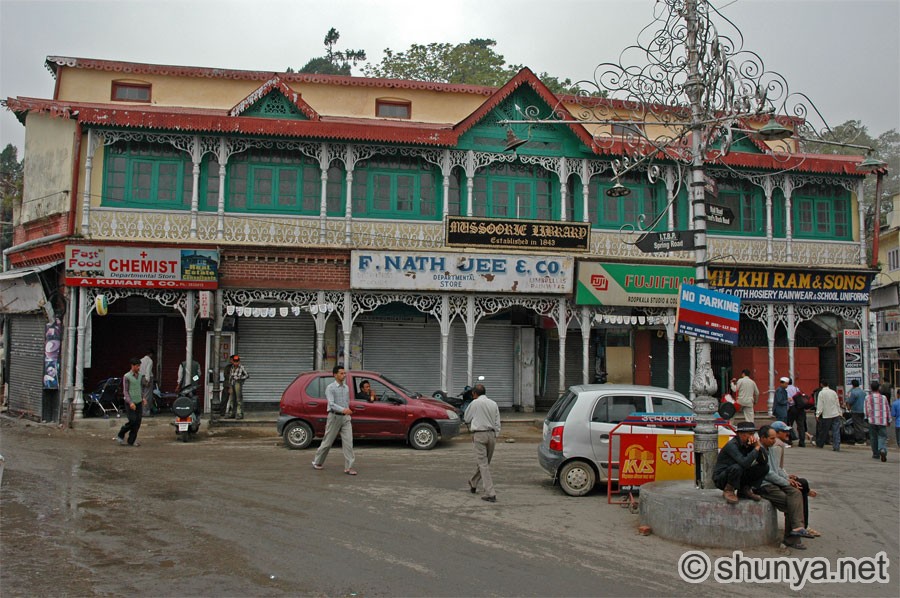

|  Date? - Statue of Mahatma Gandhi, Gandhi Chowk, Mussoorie, Uttarakhand (India). This is the commercial center of the Mussoorie hill station. Date? - Statue of Mahatma Gandhi, Gandhi Chowk, Mussoorie, Uttarakhand (India). This is the commercial center of the Mussoorie hill station.
|

.jpg)

|   December 12, 2003 - Rotary Peace Monument, Sukhna Lake, Chandigahr, Punjab (India). Incorporates shape of Le Corbusier's "Open Hand" (circa 1965). One of several peace monuments around the world inspired by the Rotary Club of Wagga Wagga, New South Wales (Australia). December 12, 2003 - Rotary Peace Monument, Sukhna Lake, Chandigahr, Punjab (India). Incorporates shape of Le Corbusier's "Open Hand" (circa 1965). One of several peace monuments around the world inspired by the Rotary Club of Wagga Wagga, New South Wales (Australia). 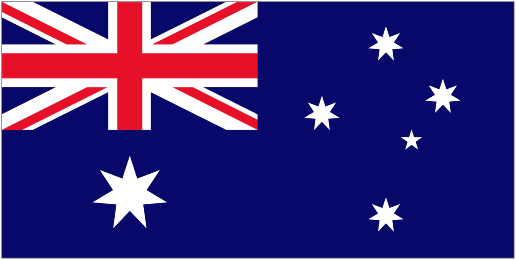
|

|  June 2004 -
Peace Sculpture, Woodstock School, Mussoorie, Uttarakhand (India). Sumerian cuneiform character for "peace" (oldest known language). Stainless steel sculpture by Jim Havens of Gibsonburg, Ohio (USA). (Sumerian is a language created out of necessity for the grain trade circa 2,500 BCE.) Photo by EWL Jan07. June 2004 -
Peace Sculpture, Woodstock School, Mussoorie, Uttarakhand (India). Sumerian cuneiform character for "peace" (oldest known language). Stainless steel sculpture by Jim Havens of Gibsonburg, Ohio (USA). (Sumerian is a language created out of necessity for the grain trade circa 2,500 BCE.) Photo by EWL Jan07. 
|

|   2008 - "The Mahatma" (Gandhi Statue), Toledo Area Sculptors Guild, 211 Cedar Street, Gibsonburg, Ohio (USA). Sculpted by James Havens. On sale for $60,000. Havens also made Peace Sculpture (qv) at Woodstock School, Mussoorie, Uttarakhand (India). 2008 - "The Mahatma" (Gandhi Statue), Toledo Area Sculptors Guild, 211 Cedar Street, Gibsonburg, Ohio (USA). Sculpted by James Havens. On sale for $60,000. Havens also made Peace Sculpture (qv) at Woodstock School, Mussoorie, Uttarakhand (India). 
|
Dehradun sits at the base of the biggest mountain range in the world, and we decided that it would be a shame not to see something of the mountains before we left India. So we stayed behind when the rest of the "Reality Tour" trained back to Delhi (most to fly directly home). We considered going to Chandigarh to see
 the peace monument constructed by the Rotary Club (in continuation of a series started in Wagga Wagga, NSW, Australia), but we set our sites on Mussoorie -- only one hour away from but several thousand feet above Dehradun -- principally to see the stainless steel peace monument sculpted by Jim Havens in Gibsonburg, a small town near Toledo, Ohio (USA). Havens based his sculpture on the world's oldest known word for "peace" and submitted it to an international competition conducted by the government of Iran for a monument to commemorate the end of Iran's war with Iraq (1980-1988), but Iran changed its mind, and Havens donated the sculpture to his alma mater in Mussoorie. Just getting to Mussoorie was an adventure! The "hill station" is strung out along an irregular ridge. Our hotel, Woodstock School, and everything else is built on very steep mountainsides. Snow-covered Hymalayas are visible to the north, and a sea of pollution is visible over the Indo-Gangetic Plain to the south. A bonus was seeing the almost primitive statue of Mahatma Gandhi in the center of this very picturesque town, as well as a nearby Sikh temple and the Tibetan colony and its temple in Mussoorie's outskirts.
Haridwar, Uttarakhand
the peace monument constructed by the Rotary Club (in continuation of a series started in Wagga Wagga, NSW, Australia), but we set our sites on Mussoorie -- only one hour away from but several thousand feet above Dehradun -- principally to see the stainless steel peace monument sculpted by Jim Havens in Gibsonburg, a small town near Toledo, Ohio (USA). Havens based his sculpture on the world's oldest known word for "peace" and submitted it to an international competition conducted by the government of Iran for a monument to commemorate the end of Iran's war with Iraq (1980-1988), but Iran changed its mind, and Havens donated the sculpture to his alma mater in Mussoorie. Just getting to Mussoorie was an adventure! The "hill station" is strung out along an irregular ridge. Our hotel, Woodstock School, and everything else is built on very steep mountainsides. Snow-covered Hymalayas are visible to the north, and a sea of pollution is visible over the Indo-Gangetic Plain to the south. A bonus was seeing the almost primitive statue of Mahatma Gandhi in the center of this very picturesque town, as well as a nearby Sikh temple and the Tibetan colony and its temple in Mussoorie's outskirts.
Haridwar, Uttarakhand

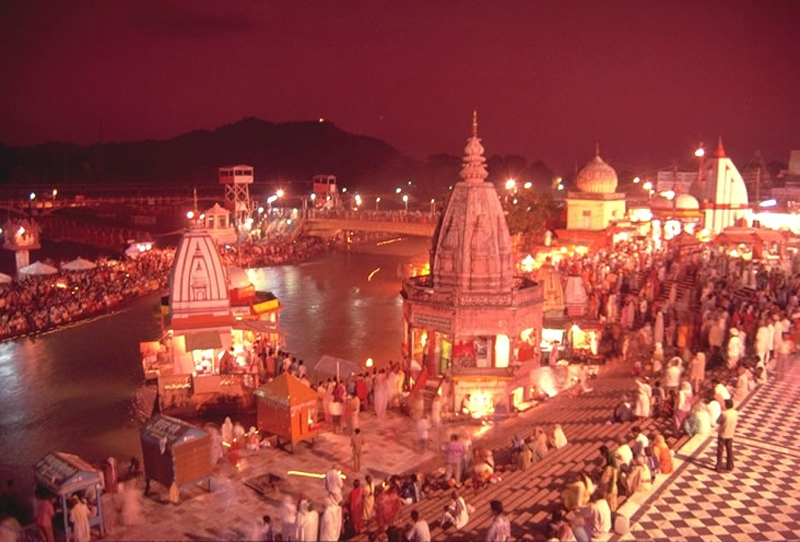

|  Date? - Har-Ki-Pauri (Sacred Ghat), on a branch of the Ganges River, Haridwar, Uttarakhand (India). "It is believed that Bhartihari eventually came to Haridwar [in the 3rd Century] to meditate by the banks of the holy Ganga. When he died, his brother King Vikramaditya constructed the Ghat. The reflection of golden hues of floral diyas in the river Ganga is the most enchanting sight in the twilight during the Ganga Arti Ceremony. It is the most important Ghat on the river Ganga, where a holy dip is a must for every devotee." Date? - Har-Ki-Pauri (Sacred Ghat), on a branch of the Ganges River, Haridwar, Uttarakhand (India). "It is believed that Bhartihari eventually came to Haridwar [in the 3rd Century] to meditate by the banks of the holy Ganga. When he died, his brother King Vikramaditya constructed the Ghat. The reflection of golden hues of floral diyas in the river Ganga is the most enchanting sight in the twilight during the Ganga Arti Ceremony. It is the most important Ghat on the river Ganga, where a holy dip is a must for every devotee."
|
As we prepared for our trip to India, we read about Rishikesh and Haridwar, two holy towns on the Ganga (Ganges River). It was easy to visit Haridwar because it's on the rail line between Deradun and Delhi. (In fact the "Reality Tour" passed through Haridwar twice without stopping either time.) Before leaving Knoxville, we asked Joe Shukla if there was anything we could bring back for him from India. He replied, "No, there isn't anything from India which I can't buy in Atlanta," but, when we described our itinerary, he exclaimed, "You're going to Haridwar?! That's where I took the ashes of both of my parents. I would really love to have some water from the Ganges." So filling a bottle of Ganges water was the first thing we did in Haridwar after finding a hotel (rather dismal, by the way). After that, we barely had time to find a place to stand for the sunset ceremony (aarti) at Har-Ki-Pauri. Hundreds (thousands?) of Hindus pressed in from all sides. Those nearest us were extremely polite and motioned for us to move closer to the river. Others, including a battery of urchins, aggressively solicited everyone in the crowd for charitable donations and for forehead decorations (bindi). The ceremony involved a lot of open flames, loud noises, and launching of leaf-suppoted diyas on the rapidly flowing waters of the Ganga. It was a fitting scene for our last evening in India. The next day, we took the train to Delhi and were met by a car and driver arranged (at our expense) by the travel agency engaged by Global Exchange. We drove back and forth around Delhi trying to kill time since our flight to Frankfurt didn't leave until 2:00 or 3:00 am, and the Delhi airport doesn't allow passengers into the transit lounge until an hour before flight time (because the airport is so over-crowded).



1989 - Global Exchange, 2017 Mission Street, 2nd Floor, San Francisco, California (USA). Sponsors an annual "Reality Tour" to India ("The Gandhian Legacy and Grassroots Development") led by Arun Gandhi. Cost (in 2009-2010) = $2900/person = $223/night for 13 nights.




1991 - M. K. Gandhi Institute for Nonviolence, c/o Christian Brothers University (CBU), Kenrick Hall, 650 East Parkway South, Memphis, Tennessee (USA). Institute co-founded by Arun Gandhi & Sunanda Gandhi. Office closed in 2006.




2000 - Publication of "Kasturba: A Life," 315-page biography of Kasturba Gandhi [1869-1944] by Arun Gandhi & Sunanda Gandhi.
![]()

2006 - M. K. Gandhi Institute for Nonviolence, House of Arun & Sunanda Gandhi, Memphis, Tennessee (USA). Sunanda Gandhi died on February 21, 2007.




2006 - Publication of "Mohandas: A True Story of a Man, his People and an Empire," 745-page biography of Mahatma Gandhi by his grandson Rajmoham Gandhi, visiting professor, University of Illinois.



June 2007 - M. K. Gandhi Institute for Nonviolence, c/o University of Rochester, Rochester, New York (USA). Arun Gandhi resigned on January 25, 2008.




May 2008 - Gandhi Worldwide Education Institute (GWEI), 418 Lake Shore Boulevard, Wauconda, Illinois (USA). Launched by Arun Gandhi. "Sunanda Gandhi died in February of 2007 and the family is working to establish a school in poorest rural India in her name." "Beginning in Vashi in the Kolhapur District of Maharastra [State] where 60,000 children live in extreme poverty, GWEI is partnering with AVANI Shelter for Rescured Child Labourers & Children in Peril (AVANI) and the Mahatma Gandhi Foundation of India, who have purchased five acres of land for the first project, the Sunanda Gandhi Memorial Home & School." Click here for website of Arun Gandhi.


December 1-6, 2009 - "Ghandian Legacy & Philanthropy Tour" sponsored by GOPhilanthropic, 54 Seminole Way, Rochester, New York (USA). Guided by Arun Gandhi & Tushar Gandhi. "The trip begins in Mumbai visiting significant Gandhian sights as well as important humanitarian projects focused on health and economic development. We then travel South to Kolhapur were the Gandhis have begun work on a school project -- the Sunanda (Gandhi) Memorial School to provide education and shelter for children who would otherwise be locked into child labor and exploitation." Cost = $2500/person + $1000 philanthropic contribution to the Sunanda Memorial School = $3500 = $700/night for 5 nights..
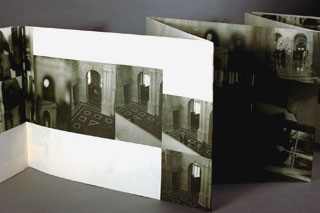

Date? - "5.Juni 1999/July 27, 1999: Love Letter to Gutenberg" by Daniela Deeg and Cynthia Lollis, 2000, edition of 500, Meinz (Germany).

Date? - Rhein River, near Koblenz (Germany).

Date? - St. Josef Krankenhaus , Bendorf am Rhein (Germany)

1955 - Mani Bhavan (Ghandi Sangaralaya), 19 Laburnum Road, Gamdevi, Mumbai, Maharashtra (India). "Whenever Gandhiji was in Mumbai between 1917 to 1934, he stayed here. It was from Mani Bhavan that Gandhi initiated Civil Disobedience, Satyagraha, Swadeshi, Khadi, and Khilafat movements." Gandhi was arrested here on January 4, 1932. The house was converted in 1955 into a museum and research centre.
Date? - Standing Statue of Mahatma Gandhi, Maharashtra State Secretariat, Mumbai, Maharashtra (India). "On February 26, 2008, Arun Gandhi was briefly held in custody for violating prohibitory orders before staging a protest in front of a statue of his grandfather at the State Secretariat in Mumbai, India. After being released, he stated his forced resignation [from the M. K. Gandhi Institute for Nonviolence in Rochester, New York] had 'implications for freedom of thought and speech' and that it 'indicates the power people have because of money and this had made a mockery of democratic principles.'"

Date? - Ambedkar Statue, near the Oval Maidan, Mumbai (India). In landscaped traffic island. "The [Dalit & Buddhist] man who framed the Indian constitution stands against the backdrop of seat of law, the Mumbai high court. Unfortunately, Babasaheb Ambedkar is used to keep the caste divide intact. His name is used to play caste politics and no one follows his ideals anymore." "When in 1994 a garland of shoes was hung around a statue of Ambedkar in Mumbai, sectarian violence and strikes paralyzed the city for over a week."



Date? - Seated Statue of Mahatma Gandhi, at police station, Juhu Beach, Mumbai, Maharashtra (India). Click here for air view. Left photo by EWL. Right photo shows Gandhi at Juhu with his son Devdas.


1968 - Women's India Trust (WIT), Kamila Tyabji WIT Centre, Bunder Road, Panvel, near Mumbai (India). "WIT remains dedicated to the original aims of its founder, Kamila Tyabji: to help women to help themselves; to encourage women from less privileged backgrounds to acquire new skills; to give them the self-confidence and self esteem required to earn by their own industry and initiative; to enable them to carry this newly discovered skill and confidence into the wider world as well as within the framework of WIT."




1978 - ISKCON Temple, Juhu, Mumbai (India). Also called Hare Rama Hare Krishna Temple. "The temple complex has a spacious marble temple, a top-end auditorium, a book-publishing house, a restaurant and a twin towered six storied guest house where visitors can stay and be a part of daily spiritual programs of the temple. Every day about 5,000 pilgrims visit the temple and on Sundays the number swells to over 10,000."

June 1980 - SHARE (Save the Handicapped's Rehabilitation Efforts), Santa Cruz, Mumbai (India). "Founded by two sisters, the non-profit SHARE, worked with low-income women to make handmade patchwork quilts. Since that time the organization has grown to include 13 cooperatives that employ over 500 members. They have also expanded their product line to include clothing and household items, and broadened their market to the United States and Australia." MarketPlace operates under the umbrella organisation. Handwork of India, a women's cooperative, makes and exports apparel to the US. Over 450 women are today managing a turnover of $780,000. The initiative has transformed their lives.
(This was the only religious site visited on the entire tour. Arun Gandhi never led us to a mosque, a church, or any other kind of temple.) /// The tour ran out of things to do at SHARE/MarketPlace. While the group sat around in a stuffy little room (and some of the women got their hands painted), I walked alone into a Hindu temple across the street and received a wonderful welcome, including a tour (both upstairs and down) of many nitches holding statues of Hindu divinities and a recital of music performed by three women sitting cross-legged in the middle of the upstairs floor. /// Also near our hotel in Juhu was St. Joseph's Church
(whose burial markers displayed Portuguese names) and St. Joseph's High School (which had a magnificent year-end display near its gate combining a salt-marching Mahatma Gandhi, Lage Raho Munna Bhai -- the recent comedy featuring the ghost of Gandhi -- symbols of many different religions, and little models of the seven Mumbai train cars which had been bombed on July 11, 2006). /// I had learned about the seated Gandhi statue at the police station on Juhu Beach from Jyotindra (Joe) Shukla (former president of the Knoxville Hindu Cultural Center), so made a point of walking there from our hotel. Getting to the Gandhi statue nestled among government buildings in central Mumbai was another matter. While the tour group dined in a seafood restaurant, I proposed to walk to the statue. Group leaders vetoed my proposal but instructed our driver and his assistant to take Schera and me there in their
immense chartered bus. I've never had such service. On our return to the restaurant, the driver asked if I'd also like to visit the statue of B. R. Ambedkar [1891-1956]. I said sure and was duly deposited on the edge of a landscaped traffic island, but no sooner had I approached the statue than a uniformed guard shooed me away. I learned later about some of the security problems which have worried Mumbai for many years (see above). /// The tour group never had a room to met in at the hotel. This meant, among other things, that we never really got to know each other and never received much input from Arun Gandhi. When his son Tushar Gandhi came to speak to us about his new book, Let's Kill Gandhi, he did so while we remained seated on our noisily air conditioned chartered bus parked in front of the hotel. Tushar Gandhi said that the principal reason for Matahma Gandhi's assassination in 1948 was opposition he had received for many years from group of Brahmins in the city of Pune.


Date? - Gandhi's Ashes, Aga Khan Palace, Pune, Maharashtra (India). Also ashes of Gandhi's wife Kasturba [1869-1944] and secretary Mahdev Desai [1892-1942], both of whom died while emprisoned in the palace.
1969 - Aga Kahn Palace, Pune, Maharashtra (India). Where Gandhi, his wife Kasturba, and his secretary Mahadevbhai Desai were interned from August 9, 1942 to May 6, 1944 (& where the latter two died). Palace built in 1892. Museum management transferred to the Gandhi Memorial Society in 1980.
Date? - Babasaheb Ambedkar Museum, Senapati Bapat Road, Pune, Maharashtra (India). "Dedicated to Dr. Babasaheb Ambedkar, a freedom fighter who later wrote the Constitution of the independent India. Contains items representing his entire life, right from his birth to his death. Also a marble statue of Dr. Babasaheb adorning the interiors of the museum."
![]()
Date? - ____ School, Sangli, Maharashtra State (India). Presided over by famous elder. Military connections.
![]()
Date? - Freedom Fighters Monument, ____ School, Sangli, Maharashtra State (India).
Date? - Seated Statue of Mahatma Gandhi, _____ Library, Sangli, Maharashtra (India). Photo by EWL


Date? - Salt March Monument, Dandi, ____, State (India). This monument stands next to a larger-than-life statue of Gandhi bending down and picking up the salty mud that he would later boil and extract salt from. The inscription reads: “Here On April 6, 1930, Gandhiji Broke The Salt Law Picked Salt And Challenged The Rule Of The Mighty British Which Ultimately Won For Our Motherland Freedom on August 15, 1947.”

May 27, 1950 - Kirti Mandir / Gandhi Birthplace, Porbandar, Gugarat (India). House where Gandhi was born on October 2, 1869. Click here for a critique.




Before 1963 - Sabarmati Ashram, Ahmedabad, Gugarat (India). Also called Harijan Ashram or Gandhi Ashram. On bank of Sabarmati River adjacent to Gandhi Memorial Instituton. Sabarmati is the starting point of the Salt March in 1930 (right image). Ashram complex includes historic preservations, prayer ground, school, and artisenal factories. When opened to the public?


May 10, 1963 - Gandhi Smarak Sangrahalaya / Gandhi Memorial Institution, Ahmedabad, Gugarat (India). On bank of Sabarmati River adjacent to Sabarmati Ashram (also called Harijan Ashram). "Houses personal memorabilia of Mahatma Gandhi. Consequently the exhibits on view depict the vivid and historic events of Gandhiji's life. There are books, manuscripts and photostat copies of his correspondence, photographs of Gandhiji with his wife Kasturba and other ashram associates, life size oil paintings and actual relics like his writing desk and spinning wheel." Operated by Sabarmati Ashar Preservation & Memorial Trust. Listed in UN directory "Peace Museums Worldwide" (1998).

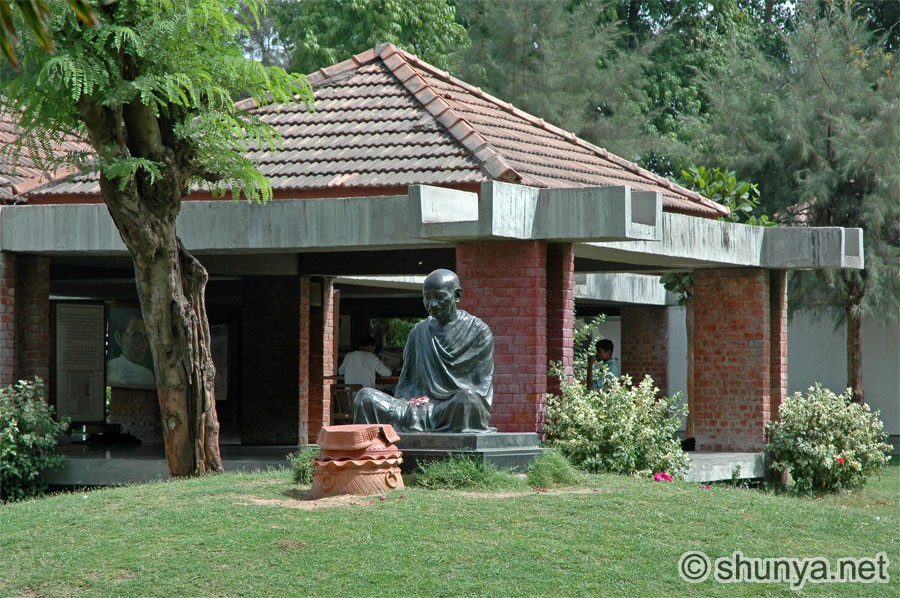
After 1963? - Seated Statue of Gandhi, Ahmenabad, Gugarat (India). On bank of Sabarmati River adjacent to Gandhi Memorial Institution.
Date? - Standing Statue of Mahatma Gandhi, Ahmedabad (India). At intersection just west of Sabaramati River bridge. Completely surrounded by traffic. Just south of Sabarmati Ashram, this intersection is where Gandhi's 1930 Salt March turned left in order to cross the Sabarmati River en route to Dandi. Photo by EWL .


1972 - Self Employed Women's Association (SEWA), Ahmenabad, Gugarat (India).

January 26, 2001 - Gandhi Statue, Gandhidham, Gugarat (India). "Many buildings, including several medium high-rise buildings collapsed during the Bhuj Earthquke on January 26, 2001. A statue of Mahatma Gandhi was knocked down as the pedestal collapsed."

October 13, 2005 - Seva Cafe, Shopper’s Plaza (4th Floor), opposite Municipal Market, C.G. Road, Ahmenabad, Gugarat (India). "Seva means service. Seva Café is an experiment in the shared joy that comes from humble giving and selfless service. As we serve, we internalize the mantra of "Atithi Devo Bhava" which translates to "The Guest is God," a deep and ancient Indian view that honors each guest with reverence. When you dine at Seva Café, you are not viewed as a customer, but instead as our treasured guest, as part of our family. "


Date? - Gandhi Statue, Roundabout, Jaipur (India).
1939 - Birla Mandir / Birla Temple, New Delhi (India). Hindu temple created in harijan / untouchable neighborhood by Gandhi and Ghanshyam Das Birla [1894-1983] to be open to all people (which it still is).



January 31, 1948 - Raj Ghat, New Delhi (India). Where Gandhi's body was cremated, and a shrine ever since. A commemorative ceremony takes place every Friday. Remembrance prayers are held on anniversaries of Gandhi's Birth ( October 2) & Death (January30). The latter is called Martyr's Day. Gandhi's ashes were sent to the Ganges, Pune (qv), other sites in India, the Nile (Uganda) & Pacific Palisades, California (USA).




Date? - "Gyarah Murti / Eleven Figures," Willingdon Crescent at Sardar Patel Marg, New Delhi (India). Sculpted by Devi Prasad Roy Choudhary [1899-1975]. Depicts Mahatma Gandhi [1869-1948] leading the Salt Satyagraha / Salt March from Ahmadabad to Dandi in 1930. Click here to see the sculpture on the 500 rupee banknote. Click here for one attempt to identify the 10 figures other than Gandhi.
Date? - Replica of Gyarah Murti / Eleven Figures, Gandhi Square, Kottayam (India). Placed in connection with the district conference of the Congress Party.
January 30, 1961 - National Gandhi Museum & Library, Rajghat, New Delhi, (India). Occupied present location in 1961, but origins of the museum go back to 1951. Operated by Gandhi Smarak Sangrahalaya Samiti. Listed in UN directory "Peace Museums Worldwide" (1998).

Date? - Statue of Gandhi on the Salt March, National Gandhi Museum & Library, Rajghat, New Delhi (India). Image courtesy of Peter Nais, director of The Peace Muesum, Bradford (England).
1969? - Gandhi Darshan or Gandhi Samadhi, Rajghat, New Delhi (India). Merged in September 1984 with Gandhi Smriti (qv) to form "Gandhi Smriti and Darshan Samiti" (GSDS).

Date? - Gandhi Statue, Gandhi Darshan or Gandhi Samadhi, Rajghat, , New Delhi (India). Image courtesy of Peter Nais, director of The Peace Muesum, Bradford (England).



August 15, 1973 - Gandhi Smriti, Birla Bhavan / Birla House, 5 Tees January Marg, New Delhi (India). Home of industrialist Ghanshyam Das Birla [1894-1983]. Now includes Gandhi museum, bookshop, room in which Gandhi lodged for 144 days after September 9, 1947, his last footsteps on January 30, 1948, and the garden in which he was assassinated. Merged in September 1984 with Gandhi Darshan (qv) to form "Gandhi Smriti and Darshan Samiti (GSDS).

Date? - Statue of Mahatma Gandhi, Gandhi Smriti, Birla Bhavan / Birla House, New Delhi (India). Depicts Gandhi with two harijan / untouchable children. Sculpted by Ram V. Sutar. Duplicate statues at Sandur, Bangalore, and Delhi Public School, Noida. Sutar also sculpted the Gandhi statue at the Martin Luther King, Jr., National Historic Site in Atlanta, Georgia (USA).



December 1986 - Bahá'í House of Worship (Lotus Temple), New Delhi (India). Click here for air view. Click here for Bahá'í Temples in other countries.

November 6, 2005 - Swaminarayan Akshardham Temple, Yamuna River, New Delhi (India). Click here for the Wikipedia article. There is an older Swaminarayan Akshardham Temple in Ahmendabd, Gujarat (India).
September 11, 2006 - World Peace Gong #2, Gandhi Smriti, Birla Bhavan / Birla House, New Delhi (India). Second permanent World Peace Gong. Dedicated by Gandhi's great grand-daughter Tara Gandhi Bhattacharjee on centennial of Gandhi's Satyagraha speech in the Empire Theater, Johannesburg (South Africa).
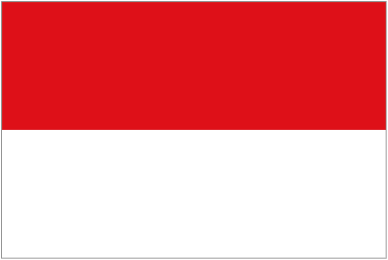
2007 - Vishwa Shanti Stupa / Peace Pagoda, Indraprasht Park, New Delhi (India). "Unveiled by His Holiness the Dalai Lama. The landmark also houses some of Budha’s relics in it. The Stupa stands against the backdrop of some magnificent historical buildings like the Old Fort and Humayun’s tomb. The “Vishwa Shanti Stupa” is 28 meters high. Its construction was inspired by the world famous Shanti Stupa at Sanchi in Madhya Pradesh (qv)....74th in the series of stupas or pagodas around the world."
Taj Mahal and Red Fort in Agra (200 km east of Delhi). Schera and I avoided Agra and the Taj. It may be the most beautiful monument in the world, but nobody claims it to be a "peace monument." (Besides, I'd seen it in 1961.) /// Instead, we had tea with Mr. and Mrs. Rajinder Singh Bedi -- whom we knew through the Rotary Global History Fellowship (RGHF) -- and visited the beautiful Lotus Temple, the colossal Swaminarayan Akshardham Temple, the impressive Gyarah Murti monument, and historic Birla House. The larger than life-size Gyarah Murti became my favorite peace monument of any time or location. (To my great regret, I have never been able to find the date on which this masterpiece was dedicated.) A visit to Birla House -- including Gandhi's last bedroom and the path he took to the prayer ground on which he was assassinated in 1948 -- would, in my opinion, be impossible to exclude from any Gandhi pilgrimage worthy of the name. The centennial of Gandhi's Satyagraha speech at the Empire Theater in Johannesburg, South Africa, had just taken place on September 11, and two centennial monuments had been added to the Birla House grounds -- an outdoor exhibit of Gandhi's career in South Africa and a huge World Peace Gong from Indonesia. I'd never heard of World Peace Gongs before, and accidentally coming across such a gong was very exciting. A clerk in the Birla House bookshop proudly showed me a copy of "Mohandas: A True Story of a Man, his People and an Empire" (not yet published in the US). Foolishly, I declined to purchase it -- but did so later. /// I regret that time did not permit our also visiting Old Delhi, the Jama Masjid Mosque, the Red Fort, Birla Mandir, the two other Gandhi museums (see above, including the two statues photographed by Peter Nais), and several other Delhi landmarks.

Date? - Statue of Mahatma Gandhi, Dehradun, Uttarakhand (India). "Gandhijiri. A worker repairs the statue of Mahatma Gandhi, which was damaged by miscreants a few days ago, at Dehradun's Gandhi Park." Typically, in the middle of a busy street and therefore difficult (and unsafe) to photograph.

1982 - Navdanya Farm & Research Foundation for Science, Technology and Ecology (RFSTE), Dehradun, Uttarakhand (India). Founded & headed by Vandana Shiva on her family farm. "The seed bank in the farm at Dehradun preserves 300 land races of paddy, 31 land races of wheat, 11 land races of barley, 5 varieties of barnyard millet, 10 varieties of oats, 6 varieties of finger millet, 3 varieties of foxtail millet, and 7 varieties of mustard." Click here for a 360-degree panorama via YouTube.
and she spoke to us at our hotel on the evening of our arrival. Next day, her brother (a retired Indian Air Force officer) welcomed us to the Navdanya farm several miles outside of town. As we walked among rice paddies, Arun Gandhi told those within earshot to look up and see a gray profile of mountains. Visible only a minute or two, this was the only view the "Reality Tour" ever received of the mountainous wall which encloses India on the north. (Pollution enveloped us everywhere else.) That evening -- the very last evening of the tour -- we had our first and only real discussion with Arun Gandhi about non-violence and other principles of his grandfather, Mahatma Gandhi. Finding a room to accomodate the 30+ members of the tour had been a constant problem since the beginning of the tour in Mumbai, and -- in our opinion -- the tour failed to live up to its one of its primary purposes, i.e. to include a running seminar with Arun Gandhi -- and with each other -- all the time we were in India.

1854 - Woodstock School, Mussoorie, Uttarakhand (India). "One of the most highly esteemed Christian international schools in South Asia. Our alumni are active in almost every part of the globe and continue to support the development of this exciting and effective centre of learning."

1959 - Tibetan Buddhist Temple, Happy Valley Road, Mussoorie, Uttarakhand (India). "Dalai Lama took refuge in Mussoorie after he fled Tibet [in 1959. Later he] was granted land in Dharamshala by the then Prime Minister Pandit Jawaharlal Nehru. The temple has a divine atmosphere, and those seeking solace and peace of mind must make it a point to visit here. To add to the serenity are the clay lamps in the lamp house and the prayer flags."




Date? - Statue of Mahatma Gandhi, Gandhi Chowk, Mussoorie, Uttarakhand (India). This is the commercial center of the Mussoorie hill station.

.jpg)


December 12, 2003 - Rotary Peace Monument, Sukhna Lake, Chandigahr, Punjab (India). Incorporates shape of Le Corbusier's "Open Hand" (circa 1965). One of several peace monuments around the world inspired by the Rotary Club of Wagga Wagga, New South Wales (Australia).


June 2004 - Peace Sculpture, Woodstock School, Mussoorie, Uttarakhand (India). Sumerian cuneiform character for "peace" (oldest known language). Stainless steel sculpture by Jim Havens of Gibsonburg, Ohio (USA). (Sumerian is a language created out of necessity for the grain trade circa 2,500 BCE.) Photo by EWL Jan07.



2008 - "The Mahatma" (Gandhi Statue), Toledo Area Sculptors Guild, 211 Cedar Street, Gibsonburg, Ohio (USA). Sculpted by James Havens. On sale for $60,000. Havens also made Peace Sculpture (qv) at Woodstock School, Mussoorie, Uttarakhand (India).

the peace monument constructed by the Rotary Club (in continuation of a series started in Wagga Wagga, NSW, Australia), but we set our sites on Mussoorie -- only one hour away from but several thousand feet above Dehradun -- principally to see the stainless steel peace monument sculpted by Jim Havens in Gibsonburg, a small town near Toledo, Ohio (USA). Havens based his sculpture on the world's oldest known word for "peace" and submitted it to an international competition conducted by the government of Iran for a monument to commemorate the end of Iran's war with Iraq (1980-1988), but Iran changed its mind, and Havens donated the sculpture to his alma mater in Mussoorie. Just getting to Mussoorie was an adventure! The "hill station" is strung out along an irregular ridge. Our hotel, Woodstock School, and everything else is built on very steep mountainsides. Snow-covered Hymalayas are visible to the north, and a sea of pollution is visible over the Indo-Gangetic Plain to the south. A bonus was seeing the almost primitive statue of Mahatma Gandhi in the center of this very picturesque town, as well as a nearby Sikh temple and the Tibetan colony and its temple in Mussoorie's outskirts.



Date? - Har-Ki-Pauri (Sacred Ghat), on a branch of the Ganges River, Haridwar, Uttarakhand (India). "It is believed that Bhartihari eventually came to Haridwar [in the 3rd Century] to meditate by the banks of the holy Ganga. When he died, his brother King Vikramaditya constructed the Ghat. The reflection of golden hues of floral diyas in the river Ganga is the most enchanting sight in the twilight during the Ganga Arti Ceremony. It is the most important Ghat on the river Ganga, where a holy dip is a must for every devotee."









